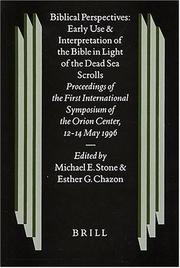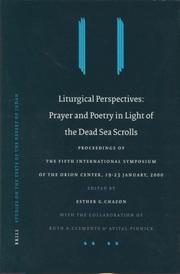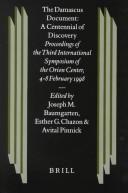| Listing 1 - 7 of 7 |
Sort by
|
Book
ISBN: 9004698078 Year: 2025 Publisher: Leiden, The Netherlands : Brill,
Abstract | Keywords | Export | Availability | Bookmark
 Loading...
Loading...Choose an application
- Reference Manager
- EndNote
- RefWorks (Direct export to RefWorks)
The Sixteenth Orion Symposium celebrated seventy years of Dead Sea Scrolls research under the theme, "Clear a path in the wilderness!" (Isaiah 40:3). Papers use the wilderness rubric to address the self-identification of the Qumran group; dimensions of religious experience reflected in the Dead Sea writings; biblical interpretation as shaper and conveyor of that experience; the significance of the Qumran texts for critical biblical scholarship; points of contact with the early Jesus movement; and new developments in understanding the archaeology of the Qumran caves. The volume both honors past insights and charts new paths for the future of Qumran studies.

ISSN: 01699962 ISBN: 9004109390 9004350292 9789004109391 9789004350298 Year: 1998 Volume: 28 Publisher: Leiden ;Boston Brill
Abstract | Keywords | Export | Availability | Bookmark
 Loading...
Loading...Choose an application
- Reference Manager
- EndNote
- RefWorks (Direct export to RefWorks)
This volume explores the use and interpretation of the Bible in the Dead Sea Scrolls and associated apocryphal, early Christian and rabbinic literature. Interpretive interests, techniques and traditions are examined in many types of ancient works: rewritten bibles, pseudepigrapha, legal codes, prayers, sapiential texts, admonitions and historical treatises. The authors highlight the contribution of the new finds from the Judean Desert to such major issues as attitudes to the Bible and the Law in antiquity, continuity and innovation vis a vis the biblical world, common and unique dimensions of interpretation among different groups in the Second Temple and Rabbinic periods in particular, the Qumran sectarians and their opponents, New Testament authors and rabbinic Sages.
Bible --- Dead Sea scrolls --- Criticism, interpretation, etc --- History --- 229*314 --- Bijbelhandschriften in Qumran --- 229*314 Bijbelhandschriften in Qumran --- Jerusalem scrolls --- ʻAin Fashka scrolls --- Jericho scrolls --- Scrolls, Dead Sea --- Qumrân scrolls --- Rękopisy z Qumran --- Shikai bunsho --- Megilot Midbar Yehudah --- Dodezee-rollen --- Kumránské rukopisy --- Documentos de Qumrán --- Textos de Qumrán --- Rollos del Mar Muerto --- Manuscritos del Mar Muerto --- Manuscrits de la mer Morte --- Dödahavsrullarna --- Kumranin kirjoitukset --- Kuolleenmeren kirjoitukset --- Qumranhandskrifterna --- Qumranin kirjoitukset --- Qumran Caves scrolls --- Criticism, interpretation, etc. --- Biblia --- Dead Sea Scrolls --- Congresses --- Bible. --- Dead Sea scrolls. --- Hermeneutics.

ISSN: 01699962 ISBN: 9004121625 9004350462 1423729722 9781423729723 9789004350465 9789004121621 Year: 2003 Volume: v. 48 Publisher: Leiden, Netherlands : Koninklijke Brill NV,
Abstract | Keywords | Export | Availability | Bookmark
 Loading...
Loading...Choose an application
- Reference Manager
- EndNote
- RefWorks (Direct export to RefWorks)
The papers published in this volume were presented at the Fifth Orion International Symposium (Jerusalem, 2000), which focused on prayer and poetry in light of the Dead Sea Scrolls. The volume examines the recently published poetical and liturgical texts from Qumran against the background of Second Temple Judaism, its biblical antecedents, and later rabbinic developments. The essays treat a variety of prayers and religious practices, as well as major issues in the history of Jewish liturgy. Topics range from magic, mysticism and thanksgiving to lamentation, fast day rituals, communal worship, and the relationship between the prayers from Qumran and the traditional Jewish prayers. The application of new Scrolls material to this breadth of topics constitutes an important contribution to the study of religious poetry, religious practice, and liturgy.
229*310 --- Jewish religious poetry, Hebrew --- -Judaism --- -229*310 Qumran --- Qumran --- Jews --- Religions --- Semites --- Religious poetry, Hebrew --- Hebrew poetry --- Piyutim --- History and criticism --- Liturgy --- Religion --- Judaism --- 229*310 Qumran --- Dead Sea scrolls --- Jerusalem scrolls --- ʻAin Fashka scrolls --- Jericho scrolls --- Scrolls, Dead Sea --- Qumrân scrolls --- Rękopisy z Qumran --- Shikai bunsho --- Megilot Midbar Yehudah --- Dodezee-rollen --- Kumránské rukopisy --- Documentos de Qumrán --- Textos de Qumrán --- Rollos del Mar Muerto --- Manuscritos del Mar Muerto --- Manuscrits de la mer Morte --- Dödahavsrullarna --- Kumranin kirjoitukset --- Kuolleenmeren kirjoitukset --- Qumranhandskrifterna --- Qumranin kirjoitukset --- Qumran Caves scrolls --- Jewish religious poetry, Hebrew. --- Worship (Judaism) --- Liturgy. --- Ritual --- Rituals --- Dead Sea scrolls. --- West Bank --- Qumrān --- Qumran Site --- QumraÌn

ISBN: 9004114629 9004350365 9789004114623 9789004350366 Year: 1999 Volume: 34 Publisher: Leiden ;Boston Brill
Abstract | Keywords | Export | Availability | Bookmark
 Loading...
Loading...Choose an application
- Reference Manager
- EndNote
- RefWorks (Direct export to RefWorks)
The papers published in this volume were presented at the Third International Orion Symposium (1998), to mark the centennial of the discovery of the Damascus Document (CD) in the Cairo Geniza and the final publication of the 4QD manuscripts in the Discoveries in the Judaean Desert series. Since its discovery, CD has sparked lively debate about its sectarian origins and halacha, issues with far-reaching implications not only for the development of Jewish law but also for the very nature of Second Temple period Judaism and its continuity into the early medieval period. The contributors examine the physical reconstruction of CD, its relationship to other legal works in the Qumran corpus and to rabbinic law. Essays on specific legal topics, as well as historical perspectives, round out the volume.
Damascus document --- Dead Sea scrolls --- 229*316.1 --- Qumran-teksten: Damascusdocument; Gemeenteregel; Hôdayot/Hymnen; Oorlogsrol --- 229*316.1 Qumran-teksten: Damascusdocument; Gemeenteregel; Hôdayot/Hymnen; Oorlogsrol --- Jerusalem scrolls --- ʻAin Fashka scrolls --- Jericho scrolls --- Scrolls, Dead Sea --- Qumrân scrolls --- Rękopisy z Qumran --- Shikai bunsho --- Megilot Midbar Yehudah --- Dodezee-rollen --- Kumránské rukopisy --- Documentos de Qumrán --- Textos de Qumrán --- Rollos del Mar Muerto --- Manuscritos del Mar Muerto --- Manuscrits de la mer Morte --- Dödahavsrullarna --- Kumranin kirjoitukset --- Kuolleenmeren kirjoitukset --- Qumranhandskrifterna --- Qumranin kirjoitukset --- Qumran Caves scrolls --- Zadokite documents --- Document of the new covenant in the land of Damascus --- Book of covenant of Damascus --- Damascus covenant --- Dead Sea scrolls. --- Midrash on the eschatological Torah --- Midrash ha-Torah ha-aḥaron --- New Damascus document --- Dead Sea Scrolls --- Criticism, interpretation, etc --- Congresses --- Damascus document - Congresses. --- Damascus document. --- Criticism, interpretation, etc. --- Hermeneutics.
Book
ISBN: 9789004183070 Year: 2010 Publisher: Leiden Boston Brill
Abstract | Keywords | Export | Availability | Bookmark
 Loading...
Loading...Choose an application
- Reference Manager
- EndNote
- RefWorks (Direct export to RefWorks)
229*3 --- 229*3 Dode Zeerollen en intertestamentaire literatuur --- Dode Zeerollen en intertestamentaire literatuur --- Dead Sea scrolls --- Jerusalem scrolls --- ʻAin Fashka scrolls --- Jericho scrolls --- Scrolls, Dead Sea --- Qumrân scrolls --- Rękopisy z Qumran --- Shikai bunsho --- Megilot Midbar Yehudah --- Dodezee-rollen --- Kumránské rukopisy --- Documentos de Qumrán --- Textos de Qumrán --- Rollos del Mar Muerto --- Manuscritos del Mar Muerto --- Manuscrits de la mer Morte --- Dödahavsrullarna --- Kumranin kirjoitukset --- Kuolleenmeren kirjoitukset --- Qumranhandskrifterna --- Qumranin kirjoitukset --- Qumran Caves scrolls --- Conferences - Meetings
Book
ISBN: 1282786857 9786612786853 9004190813 9789004190818 9004183078 9789004183070 Year: 2010 Publisher: Leiden ; Boston : Brill,
Abstract | Keywords | Export | Availability | Bookmark
 Loading...
Loading...Choose an application
- Reference Manager
- EndNote
- RefWorks (Direct export to RefWorks)
This volume presents new perspectives on the ancient texts discovered at Qumran. The essays offer fresh insights into particular texts and genres, by applying methods and constructs drawn from other disciplines to the study of the Dead Sea Scrolls, and by exploring new as well as long-standing issues raised by these works. The topics and approaches engaged include group identity, memory, ritual theory, sectarian sociology, philosophy of education, liturgical anthropology, Jewish law, history of religion, and mysticism. The articles in this volume were originally presented at the Tenth Annual International Orion Symposium sponsored in 2005 by the Orion Center for the Study of the Dead Sea Scrolls and Associated Literature at the Hebrew University of Jerusalem.
Book

ISBN: 9789004698062 9789004698079 9004698078 Year: 2025 Publisher: Leiden, The Netherlands : Brill,
Abstract | Keywords | Export | Availability | Bookmark
 Loading...
Loading...Choose an application
- Reference Manager
- EndNote
- RefWorks (Direct export to RefWorks)
The Sixteenth Orion Symposium celebrated seventy years of Dead Sea Scrolls research under the theme, "Clear a path in the wilderness!" (Isaiah 40:3). Papers use the wilderness rubric to address the self-identification of the Qumran group; dimensions of religious experience reflected in the Dead Sea writings; biblical interpretation as shaper and conveyor of that experience; the significance of the Qumran texts for critical biblical scholarship; points of contact with the early Jesus movement; and new developments in understanding the archaeology of the Qumran caves. The volume both honors past insights and charts new paths for the future of Qumran studies.
| Listing 1 - 7 of 7 |
Sort by
|

 Search
Search Feedback
Feedback About UniCat
About UniCat  Help
Help News
News